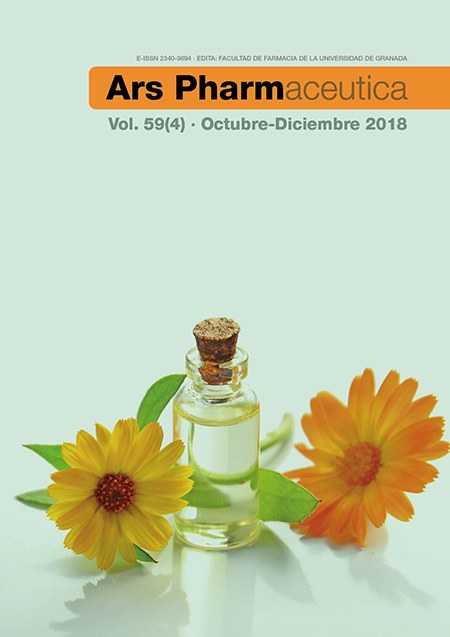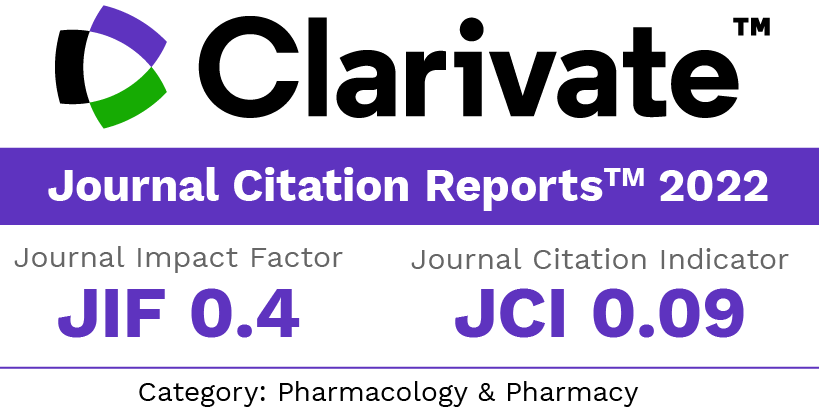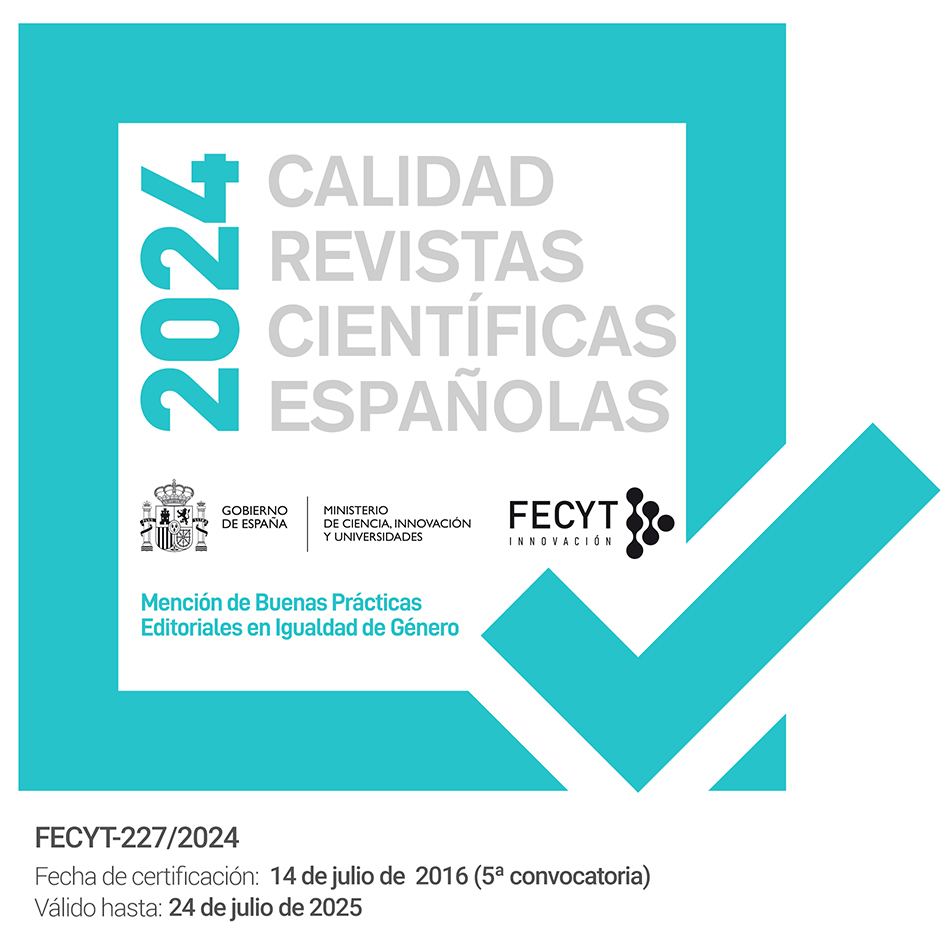Validation of an analytical method by HPLC applicable to the cuban Mangiferin
DOI:
https://doi.org/10.30827/ars.v59i4.7430Keywords:
Mangiferin, chromatographic method, validationAbstract
Purpose: The purpose of this study was to validate, in accordance with international standards, a chromatographic method to determine the mangiferin in Cuban’s samples, obtained from Mangifera indica leaves.
Materials and Methods: A GraceSmart RP -18 (150 mm x 4,6 mm i.d., 5µm particle size) column and mobile phase of potassium dihydrogen orthophosphate (0.01 M) pH 2.7 ± 0.2 – acetonitrile (85:15, v/v) with the flow rate of 1,0 mL/min and UV detection at 254 nm wavelength is used. The validated method was compared with the established method for the quality control of the Cuban’s mangiferin samples, through the Student test. In the validation study the parameters were evaluated: specificity, precision (repeatability, intermediate precision and reproducibility), accuracy, linearity, robustness and detection and quantification limits.
Results and Discussion: It was demonstrated that the developed procedure, was the sufficiently lineal thing, with a detection limit of 10 % and 30 % like quantification limit, specific, precise, exact and robust for the determination of mangiferin content in the Cuban’s samples. The results obtained from the validation process provided documentary evidence of the reliability of the chromatographic method; In addition, no significant differences were observed between the chromatographic methods evaluated, so that the validated method can be applied in the quality control of the Cuban’s samples.
Conclusions: The method used in the quantification of mangiferin was was specific, lineal, precise, exact and robust, for quality control and stability study.
Downloads
References
Food and Agriculture Organization. FAOSTAT database collections, agricultural data, food and agriculture organization of the United Nations. 2005. Available from: <http://faostat.fao.org>, accessed April 2006.
Masibo M, He Q. Major mango polyphenols and their potential significance to human health. Compr. Rev. Food Sci. Food Saf. 2008;7: 309–319. doi.org/10.1111/j.1541-4337.2008.00047.x
Kant S, Sinha SK, Prasad SK, Kumar R, Bithu BS, Sadish S. Synthesis and evaluation of novel analogues of mangiferin as potent antipyretic. Asian Pac. J. Trop. Med. 2011; 4(11): 866-9. doi.org/10.1016/S1995-7645(11)60210-1.
Choudhary R, Swarnkar P. Antioxidant activity of phenolic and flavonoid compounds in some medicinal plants of India. Nat. Prod. Res. 2011; 25(11): 1101-9. doi.org/ 10.1080/14786419.2010.498372
Muanza DN, Euler KL, William L, Newman DJ. Screening for antitumor and anti-HIV activities of nine medicinal plants from Zaire. Int. J. Pharmacol. 1995; 33 (2): 98-106. doi.org/10.3109/13880209509055207
Makare N, Bodhankar S, Rangari V. Immunomodulatory activity of alcoholic extract of Mangifera indica L in mice. J. Ethnopharmacol. 2001; 78 (2-3): 133-137. PMID:11694357
Gottlieb M, Leal-Campanari R, Campos MR, Sanchez M V, Alberdi E, Arranz, A. Neuroprotective by two polyphenols following excitotoxicity and experimental ischemia. Neurobiol Dis. 2006; 23 (2): 374-386. doi.org/10.1016/j.nbd.2006.03.017
Anexo I: Buenas Prácticas para Laboratorio de Control de Medicamentos. Validación de Métodos Analíticos. Centro Estatal para el Control de Medicamentos (CECMED); 2013: 3-25.
Nagaraj G, Pradeep K, Surender P, Mashru R. ICH Guidance in Practice: Validated Reversed – Phase HPLC Method for the determination of active Mangiferin from Extracts of Mangiferin Indica Linn. J Chromatogr Sci. 2010;48(2):156-160. PMID:20109296
Romero JA, Vandama R, López M, Capote M, Ferradá C, Carballo C, Delgado R, VanderBerghe W, Apers S. Study of Physicochemical parameters of different cultivars of Mangifera indica L. leaves for their use as a source of Mangiferin. J Pharmacogn Phytochem. 2015; 7(3): 608-612.
Farmacopea de Estados Unidos. Formulario Nacional [USP 37/ NF 33]. Volumen (; III. The United States Pharmacopeial Convention. Rockville. MD: Twinbrook Parkway; 2015.
Guidance for Industry. Analytical Procedures and Methods Validation Chemistry, Manufacturing and Controls Documentation. FDA. Rockville, Maryland. Centre for Drug Evaluation and Research; 2001.
Bliesner DN. Validating Chromatographic Methods: A Practical Guide. NJ, USA: John Wiley & Sons, Inc; 2006.
Chan CC, Lam H, Lee YC, Zhang X. Analytical Method Validation and Instrument Performance Verification. Hoboken. NJ: John Wiley & Sons, Inc; 2004.
Curiel H, Sordo L, Vélez H. Determinación cuantitativa por electroforesis capilar de zona de mangiferina en ingrediente farmacéutico activo VIMANG®. Revista CENIC Ciencias Químicas. 2007; 38 (2): 337-343.
Romero JA, Nuevas-Paz L, López M, Ferradá C, Carballo C. Validación de una técnica por Cromatografía Líquida de Alta Resolución para la determinación del contenido de Mangiferina en hojas de Mangifera indica L. Revista cubana de Plantas Medicinales 2014; 19(3): versión online ISSN 1028-4796.
Jenke RD. Chromatographic Method Validation: A Review of Current Practices and Procedures. II. Guidelines for Primary Validation Parameters. J. Liq. Chromatogr. Relat. Technol. 1996; 19 (5): 737 – 757. doi.org/10.1080/10826079608005534
Published
How to Cite
Issue
Section
License
Copyright (c) 2018 Caridad Margarita García Peña, Alejandro Felipe, Tania Naessens, Ken Foubert, René Delgado, Claudia Mora, Vivian Martínez

This work is licensed under a Creative Commons Attribution-NonCommercial-ShareAlike 4.0 International License.
The articles, which are published in this journal, are subject to the following terms in relation to the rights of patrimonial or exploitation:
- The authors will keep their copyright and guarantee to the journal the right of first publication of their work, which will be distributed with a Creative Commons BY-NC-SA 4.0 license that allows third parties to reuse the work whenever its author, quote the original source and do not make commercial use of it.
b. The authors may adopt other non-exclusive licensing agreements for the distribution of the published version of the work (e.g., deposit it in an institutional telematic file or publish it in a monographic volume) provided that the original source of its publication is indicated.
c. Authors are allowed and advised to disseminate their work through the Internet (e.g. in institutional repositories or on their website) before and during the submission process, which can produce interesting exchanges and increase citations of the published work. (See The effect of open access).























